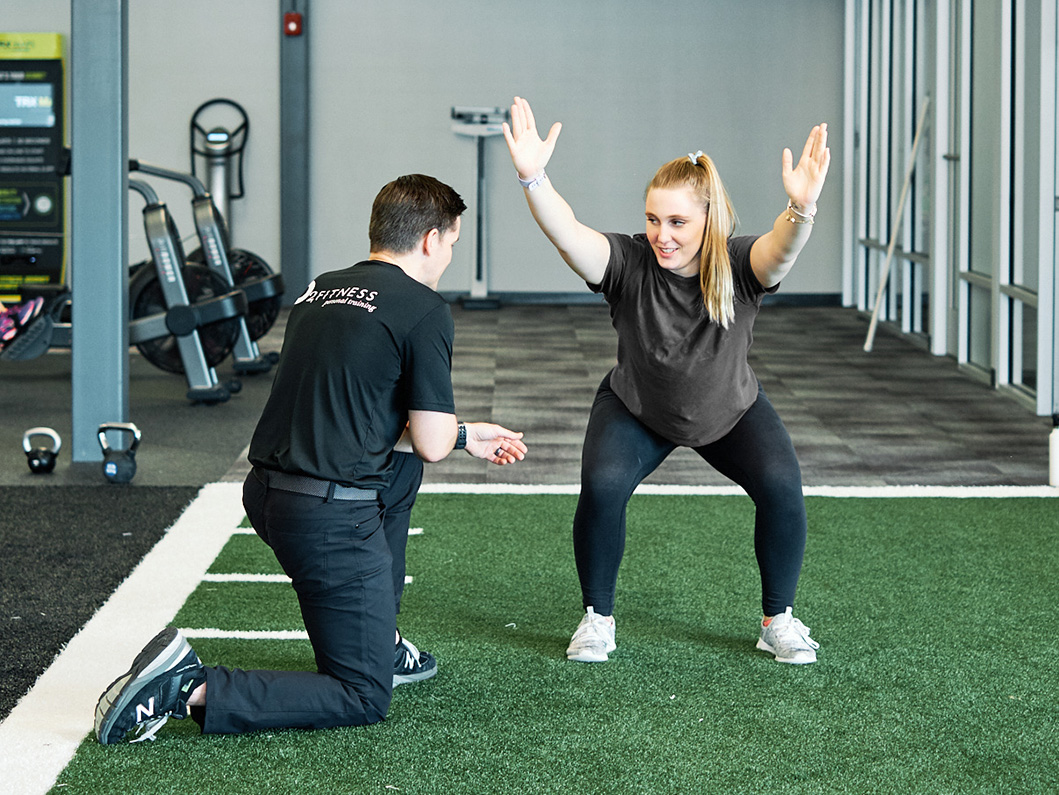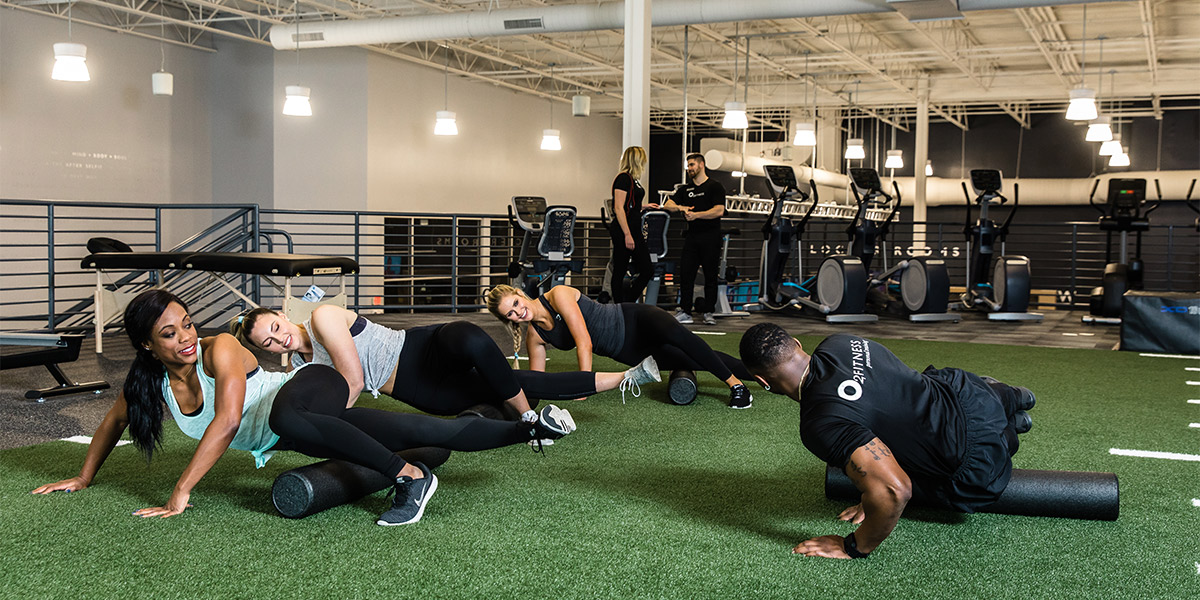Corrective Exercise
When you are suffering from pain and discomfort in your body what is your first line of defense? Do you go to the doctor? Do you stretch? Rest? Get a massage? Usually what works best is a combination of these actions. That is exactly what corrective exercise is. Corrective exercise is a comprehensive, all inclusive, holistic approach to healing the body.
Corrective Exercise can be used to help bridge the gap from physical therapy and help you return to a regular workout routine safely. It can be used to help prepare you for an upcoming surgery (Prehab). Corrective exercise can be used to help combat repetitive motions that occur daily, that leave you more at risk for injury, joint dysfunction, or pain. For example; sitting, driving, working on the computer, manual labor, reaching, bending, etc.
Corrective exercise does not take the place of seeing a Physical Therapist, Chiropractor, or Doctor. If you have sharp pain, burning sensations, or extreme limitations in range of motion please seek a medical professional first to make sure there is nothing seriously wrong.
In many cases corrective exercise can be the foundation of a fitness journey that will last for years with lower rates of injury and discomfort. Corrective exercise will stabilize joints, increase mobility, and make the body stronger. It doesn’t matter if you are a power lifter, body builder, Olympic lifter, weekend warrior, swimmer, golfer, or retiree, corrective exercises should serve as a foundation to what you do in the gym regularly to keep your joints healthy, muscles supple, and pain levels down.
Assessments
Assessments are the best way to understand what might be causing pain, discomfort, or why certain joints are dysfunctional. Think of the mechanic that wants to fix the car for you. He must run a diagnostic test before he dives in, this is no different. We could tinker around for a while and try a few things to see if we have some success. It makes much more sense to run an assessment first and identify the real issue at hand.
The National Association for Sports Medicine (NASM) advocates for a few different types of assessments including active and static (or passive). The O2 Fitness Personal Training team's assessment tools are static posture, movement, range of motion, and strength tests. Each assessment is unique in that it gives us different pieces to the puzzle that is dysfunction and will help us identify the best corrective exercises for you. Think of the overall dysfunction as a giant puzzle to solve. We need clues, hints, and validation of observations to build the entire case. The assessments are these clues.
As a quick example let’s start with Mrs. Jones. Mrs. Jones is complaining of shoulder discomfort when she attempts to get things off the shelves in her home and when she wakes up in the morning. We start with a static posture assessment. Static posture is a very simple assessment that involves viewing the body in a natural standing position from the front, sides, and back. Once we see someone has forward rounded shoulders we could infer that they have tight chest and latissimus dorsi (sides of the back) muscles. We will not know for sure until we assess the joint and the muscles with range of motion tests and a movement screen.
Movement assessments allow us to see the body in motion and how certain muscles, ligaments, and tendons interact with each other (or do not interact with each other). Let’s keep with the forward rounded shoulders example. After the static posture assessment, we ask Mrs. Jones to place her arms over her head and squat. What we see is that her hands cannot stay over her head as she squats. Her arms fall forward. This helps to confirm what we saw in the static posture assessment.

Now to make sure we are seeing consistent results of these assessments, we will test her range of motion. We look at her shoulder to determine if she has full range of motion. When she is lying flat on her back on a table bring her arm over her head easily with no pain. This is also an example of comparing active vs. passive ranges of motion. Active range of motion tests like the overhead squat assessment give us more information related to muscle strength, pain points in the range of motion, and the control a person has of their body or neuromuscular control. We might also use an upper body range of motion assessment separate from the overhead squat assessment to look at internal and external rotation of the shoulder too.
Lastly, we would want to test Mrs. Jones with a manual muscle assessment. We use the manual muscle testing to determine which muscles are weak or compensating. We also use manual muscle testing to determine which muscles are overactive and which muscles need to be reactivated or reintegrated.
Once we have completed our assessments, we can create the corrective exercise plan. The corrective exercise continuum as described by the National Association of Sports Medicine has four main components. Now let’s talk about those critical components and how they apply to creating better overall function.
Components of Corrective Exercise
There are four main components to corrective exercise as described by the National Association for Sports Medicine (NASM). Think of them like spokes to a wheel. If a spoke is absent or broken the wheel doesn’t roll evenly. All the “spokes” must be present to allow for your “fastest time” or “best performance.” The “spokes” to the corrective exercise wheel are Inhibition, Lengthen, Activation, and Integration. Let’s break down each one to better understand how they play a part in corrective exercise.
Inhibition or Foam Rolling
Inhibition is also known as self-myofascial release (SMR) or simply foam rolling. Foam rolling is something that is done to muscles that we deem overactive in our assessments. We foam roll to release these muscles from a constant state of tension. They usually end up in this state because the body notices an unstable joint and wants stability for safety. Now, the body sends a signal to little stabilizers to “hold on tight fellas!” This can create trigger points or areas of pain. When we foam roll we use certain techniques to release these muscles that have been “holding on for dear stability!” Once these muscles are released, we move to step two of the corrective exercise continuum. Step two is lengthening.

Lengthening or Stretching
After a muscle has been released, we need to attempt to retrain this muscle. Think of it like tuning a piano. When a piano has wires installed these wires can snap back to their original length because they have not been conditioned or trained to stay at the new and proper length. Muscles are similar. Depending on how long they have been overactive it might take many sessions of foam rolling and lengthening to have them stay at the optimal length. We have a couple of different techniques that we use to do this. We can use static stretching or neuromuscular stretching or proprioceptive neuromuscular facilitation (PNF). After we have released and lengthened the overactive muscles for Mrs. Jones. For this example, we will say it is her outer back muscles and chest muscles. We can now begin to strengthen the weak or inactive muscles.
Activation or Isolation Exercises
When we did the initial assessments on Mrs. Jones, we noticed her hands fell forward and her shoulders were rounded forward. These are very common signs of a very common dysfunction we see at O2 Fitness all of the time called upper cross syndrome. Upper cross typically leads to shoulder discomfort, possible shoulder impingement issues, and an unstable shoulder. To help stabilize the shoulder we need to strengthen the supporting musculature. We need to activate or turn on the muscles that have been “on vacation.” Just like any of us once we get used to taking some time off we get a little lazy. Our muscles are no different. That old expression, “if you don’t use it, you lose it” is very true when it comes to the human body. The muscles in this example that we would want to strengthen are the mid and lower traps (mid and lower back), rotator cuff (around the shoulder blade), and posterior deltoid (back of the shoulder joint). To strengthen these muscles we can choose from one of two techniques. Positional Isometrics and Isolated Strengthening. We use these two techniques specifically because they help to increase neuromuscular coordination. Just to reiterate, please make sure that the foam rolling, and stretching has occurred first. Without completing these actions first, the muscles that we are attempting to activate may not fire optimally which means they may not recover or strengthen themselves as quickly. For Mrs. Jones here are the exercises we would use.
- Standing Cable External rotation
- Ball combo 2
- Cable Reverse Fly
We would want Mrs. Jones to do these exercises 3-5 days per week. She should complete 1-2 sets and 10-15 repetitions. Each repetition should be performed with a 2 second hold at the end range of motion along with a 4 second eccentric or lengthening phase. Once we have activated these stabilizers and under active muscles, we can move to the last piece of the corrective exercise continuum which is called integration.
Integration or Integrated Dynamic Movement
In order to continue to train the central nervous system to recognize these muscles as a part of our everyday movement patterns we need to re-train the body to have it move the new and improved way repeatedly. Think of this like practicing a sporting move like a juke, a cut, shooting a basketball, dribbling a soccer ball, patterning your golf swing, etc. We will be using full body movements to integrate all the muscles together. For Mrs. Jones we will select a few integration exercises like the single arm row to arrow position and the single leg Romanian deadlift to PNF pattern. These exercises would be worked into Mrs. Jones’ overall exercise or training routine. She would perform these exercises 3-5 days a week. Doing 2-3 sets and between 10-15 repetitions. There are corrective strategies for many common impairments and dysfunctions.
Common Impairments or Dysfunctions
Some of the common areas that we see impairments are foot and ankle, knee, lumbo-pelvic hip region, shoulder, elbow, wrist, and cervical spine. We can and have developed exercise strategies for many of these areas already. We would be happy to discuss your specific situation with you at one of our local O2 Fitness Locations. Speaking with an O2 Personal Trainer is the best way to get a personalized plan. You can also review our general strategies for specific impairments like, tennis elbow, shoulder impingement, runners knee, low back pain, and plantar fasciitis. We hope this article has been helpful in showing you what a corrective exercise program is and how it can be helpful. We look forward to speaking with you or meeting you in one of our local O2 Fitness locations soon!








.jpeg)
.jpg)
.jpg)